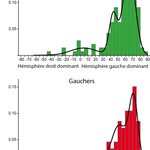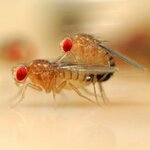Neuroscience

Using a large psychometric and brain imaging database, researchers in the Groupe d'Imagerie Neurofonctionnelle (CNRS/CEA/Université de Bordeaux) say they have determined that the location of language areas in the brain is independent of left- or right-handedness, except for a very small proportion of left-handed individuals whose right hemisphere is dominant for both manual work and language.
Humans are the only species in which asymmetric motor behavior is preponderant: 90% of people prefer to use their right hand and 10% their left hand. This motor behavior is "cross-lateralized":…
Motörhead concert goers may have to sign a waiver before they buy tickets. If that band were in California, they would have to wear a Proposition 65 warning on their shirts.
Why? Because they can give you brain damage, according to a Case Report published in The Lancet. Ariyan Pirayesh Islamian and colleagues from the Hannover Medical School, detail the case of a man who developed a chronic subdural hematoma (bleeding in the brain) after headbanging at a Motörhead concert.
In January 2013, a 50-year-old man came to the neurosurgical department of Hannover Medical School with a 2 week history…

Why do females sometimes ignore males and sometimes stop and pay attention?
There are many conjectures: looking like Ryan Gosling seems to help but there are a lot of other variables: if the female is under the age of 30, a male being unemployed while he 'gets his band together' is sometimes fine, yet after age 30 females regard that as unacceptable.
It's not legal to research on humans so psychologists are stuck with surveys of college students, but biologists can study flies. And it holds true there; if you are going to get a mate, you first have to get her to notice. Researchers can…

Optogenetics is a technology that allows scientists to control brain activity by shining light on light-sensitive proteins that can suppress or stimulate electrical signals within cells. In the last 15 years, optogenetics has become a common laboratory tool for shutting off or stimulating specific types of neurons in the brain, allowing neuroscientists to learn much more about their functions.
It has limitations. It requires a light source to be implanted in the brain, where it can reach the cells to be controlled, but now engineers have now developed the first light-…

Neurons are vital to the functional organization of the central nervous system. Multiple cell types are present within any brain structure, but the rules governing their positioning, and the molecular mechanisms mediating those rules, are unknown.
A new study finds that a particular neuron, the cholinergic amacrine cell, creates a "personal space" in much the same way that people distance themselves from one another in an elevator. The study also says that this feature is heritable and identifies a genetic contributor to it, pituitary tumor-transforming gene 1 (Pttg1).
Patrick Keeley, a…

You can't coddle kids or their brains too much. Without a little bit of frustration and stress, they would never learn how to talk or read or do science. Without some physical stress, we would all be crawling from place to place.
Stress helps us learn, adapt and cope. But too much stress, such as from neglect or abuse, can be toxic. A team of University of Wisconsin-Madison researchers writing in Biological Psychiatry recently showed these kinds of stressors, experienced in early life, might be changing the parts of developing children's brains responsible for learning, memory and the…

It's no secret that people who are tired don't perform well but a new study tackles the impact of being a morning person or a night owl on driving performance.
By measuring people when they are out of sync with their "chronotype" whether they are physiologically more active during the day or night - influences driving performance, and which chronotype performs better at a non-optimal time.
Result: evening-types are much worse drivers at their non-optimal time of day, early in the morning, while morning-types were more stable drivers than evening-types and drove relatively well both in…

Complementing the five basic tastes of sweet, bitter, salty, sour and umami, a large variety of odors also contribute to the overall sensory impression of a foodstuff.
Taste is big business, and that means science is on the case. In recent decades, approximately 10,000 volatile food compounds have been identified. Scientists from Technische Universität München (TUM) and the German Research Center for Food Chemistry (DFA) have carried out a meta-analysis on the odorant patterns of 227 food samples.
How cognac gets its complex notes
They were surprised to find that the almost…

People with persistent ringing in the ears – a condition known as tinnitus – process emotions differently than those with normal hearing, according to a new paper.
Tinnitus afflicts 50 million people in the United States, according to the American Tinnitus Association, and causes those with the condition to hear noises that aren't really there. These phantom sounds are not speech, but rather whooshing noises, train whistles, cricket noises or whines. Their severity often varies day to day.
University of Illinois speech and hearing science professor Fatima Husain, who led the study, said…

Cold Spring Harbor, NY – There are new clues about malfunctions in brain cells that contribute to intellectual disability and possibly other developmental brain disorders.
Professor Linda Van Aelst of Cold Spring Harbor Laboratory (CSHL) has been scrutinizing how the normal version of a protein called OPHN1 helps enable excitatory nerve transmission in the brain, particularly at nerve-cell docking ports containing AMPA receptors (AMPARs). The study provides new mechanistic insight into how OPHN1 defects can lead to impairments in the maturation and adjustment of synaptic strength of AMPAR-…